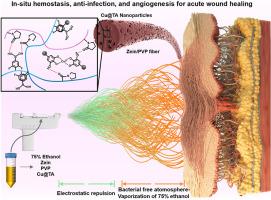具有快速止血、抗感染和血管生成作用的便携式原位静电纺丝纳米纤维敷料即时治疗急性皮肤伤口
IF 18
1区 医学
Q1 ENGINEERING, BIOMEDICAL
引用次数: 0
摘要
交通事故和自然灾害造成的急性创伤日益普遍,带来了多方面的挑战,如不规则伤口出血和易受微生物感染。本文制备了原位点纺丝玉米蛋白/聚乙烯吡咯烷酮纳米纤维与单宁酸基铜纳米粒子(CTZP)配合的生物活性敷料。CTZP在大鼠断尾模型中具有快速止血作用。体外凝血实验验证了CTZP能在1 min内实现凝血。研究发现,CTZP可通过PI3K-Akt信号通路通过TBXAS1的表达激活血小板。此外,体外成管实验表明,CTZP具有促进血管生成的作用。qPCR结果显示,Zein/Polyvinylpyrrolidone (ZP)底物可以通过提高VEGF的生成来促进血管生成。此外,单宁酸铜纳米颗粒(Cu@TA)的加入进一步增强了VEGF的促进作用,并通过PI3K-Akt信号通路协同上调eNOS的表达,这与血小板活化的途径相同。此外,体内免疫组化结果证实了血管生成相关蛋白VEGF和CD31的上调。此外,Cu@TA纳米颗粒通过类芬顿反应生成羟基自由基和铜离子释放,使CTZP敷料具有较强的抗菌活性。最终,利用金黄色葡萄球菌感染的大鼠伤口模型进行体内实验,证实了CTZP具有显著的伤口愈合功效。这些发现促进了原位静电纺丝技术在急性创伤护理中的实际应用,为设计止血、抗感染和血管生成伤口敷料提供了理论和材料上的见解。本文章由计算机程序翻译,如有差异,请以英文原文为准。

Point-of-care treatment of acute skin wound by portable in-situ electrospinning nanofiber dressings with rapid hemostasis, anti-infection, and angiogenesis effects
The increasing prevalence of acute traumatic injuries caused by traffic accidents, and natural disasters presents multifaceted challenges such as hemorrhages in irregular wounds and being susceptible to microbes. Herein, in situ point-of-care electrospun Zein/Polyvinylpyrrolidone nanofiber bioactive dressings coordinated with tannic acid-based copper nanoparticles (CTZP) are prepared. CTZP exhibits rapid hemostasis performance in rat tail amputation model. And in vitro blood coagulation experiment verifies that CTZP can achieve blood coagulation within 1 min. It has been found that CTZP can activate platelet through the expression of TBXAS1 via PI3K-Akt signaling pathway. Furthermore, the in vitro tube forming assay present that CTZP has an angiogenetic promotion effect. The qPCR result reveals that Zein/Polyvinylpyrrolidone (ZP) substrate can realize angiogenesis promotion by elevating the production of VEGF. Moreover, the addition of tannic acid-based copper (Cu@TA) nanoparticles further enhances VEGF promotion effect and synergistically upregulates the expression of eNOS by PI3K-Akt signaling pathway which is the same as the pathway in platelet activation. In addition, the in vivo immunohistochemistry results confirm the upregulation of VEGF and CD31 which are angiogenesis-related proteins. Besides, Cu@TA nanoparticles endow CTZP dressings with potent antibacterial activity through hydroxyl radical generation via Fenton-like reaction and copper ion release. Eventually, in vivo experiment using an S. aureus-infected rat wound model confirms CTZP's significant wound-healing efficacy. These findings advance the practical application of in situ electrospinning technology for acute trauma care, providing both theoretical and material insights for designing hemostatic, anti-infection, and angiogenetic wound dressings.
求助全文
通过发布文献求助,成功后即可免费获取论文全文。
去求助
来源期刊

Bioactive Materials
Biochemistry, Genetics and Molecular Biology-Biotechnology
CiteScore
28.00
自引率
6.30%
发文量
436
审稿时长
20 days
期刊介绍:
Bioactive Materials is a peer-reviewed research publication that focuses on advancements in bioactive materials. The journal accepts research papers, reviews, and rapid communications in the field of next-generation biomaterials that interact with cells, tissues, and organs in various living organisms.
The primary goal of Bioactive Materials is to promote the science and engineering of biomaterials that exhibit adaptiveness to the biological environment. These materials are specifically designed to stimulate or direct appropriate cell and tissue responses or regulate interactions with microorganisms.
The journal covers a wide range of bioactive materials, including those that are engineered or designed in terms of their physical form (e.g. particulate, fiber), topology (e.g. porosity, surface roughness), or dimensions (ranging from macro to nano-scales). Contributions are sought from the following categories of bioactive materials:
Bioactive metals and alloys
Bioactive inorganics: ceramics, glasses, and carbon-based materials
Bioactive polymers and gels
Bioactive materials derived from natural sources
Bioactive composites
These materials find applications in human and veterinary medicine, such as implants, tissue engineering scaffolds, cell/drug/gene carriers, as well as imaging and sensing devices.
 求助内容:
求助内容: 应助结果提醒方式:
应助结果提醒方式:


